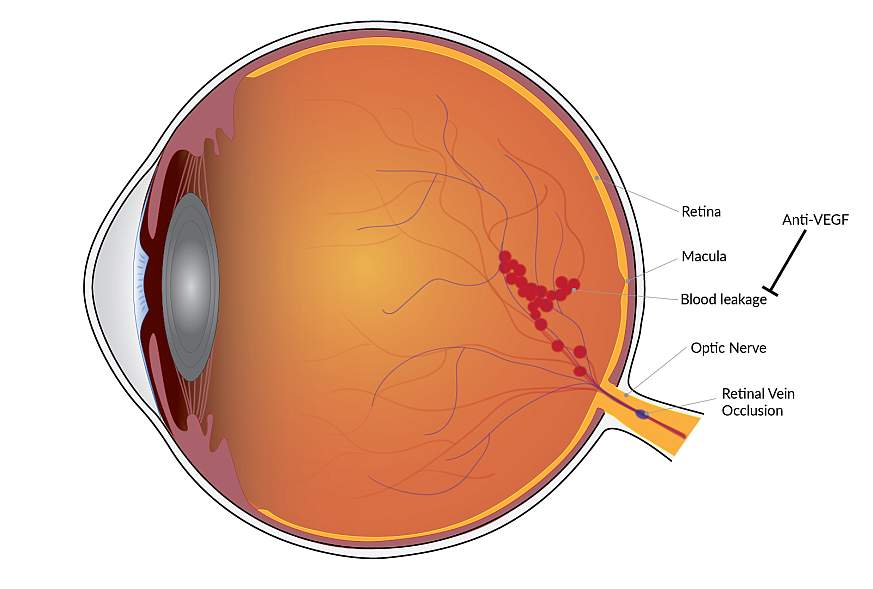Central Retinal Vein Occlusion (CRVO)

Central retinal vein occlusion (CRVO) is the most common disease of the retinal vessels. It refers to a blockage of the vein draining the retinal tissue at the back of the eye. Occurring mostly in the elderly or middle-aged, it causes a subacute loss of vision.
Types of CRVO
CRVO may be ischemic or non-ischemic. These two types need to be distinguished because of the marked difference in their prognosis and management.
Non-ischemic CRVO is considered benign. The major sequel is a permanent central scotoma following on from cystoid macular edema. Neovascularization is unknown in this variant of the disease. Over 80% of patients with CRVO have this type.
On the other hand, ischemic CRVO is a serious condition leading in many cases to progressive glaucoma brought on by neovascularization of the anterior segment of the eye. Its outcome is often blindness. This type accounts for a fifth of cases of CRVO.
Risk factors for CRVO include:
- Glaucoma of long duration
- Elderly age
- Diabetes mellitus
- Hypertension
- Hyperviscosity syndromes
- Coagulation disorders
- Migraine
Complications
Ischemic CRVO leads to neovascular glaucoma in about half of the cases. Other complications include:
- Vitreous hemorrhage
- Macular degeneration
- Optic atrophy
- Proliferative retinitis
- Loss of the eye
Non-ischemic CRVO results in the formation of a central visual field defect as a result of chronic macular edema with cystoid macular degeneration. More than a tenth of these patients go on to develop ischemic CRVO within 18 months.
Risk factors for CRVO include diabetes, hypertension, glaucoma and, in younger patients, inflammatory conditions or coagulation disorders, including the use of anticoagulants and antiplatelet agents.
Diagnosis
Diagnosis of the condition is based on the clinical and ocular examination findings. When the central retinal vein is blocked by a clot, venous stasis is the result. The optic disc shows edema, with hemorrhages in the pre-retinal hemorrhage, as well as cotton wool exudates. This appearance is called the “blood and thunder” fundus.
Various tests are required to confirm the diagnosis, such as:
Function Tests
Visual Acuity
This is markedly reduced in most patients with ischemic CRVO as compared to only a fifth of patients with the non-ischemic type
Peripheral Field of Vision
Peripheral visual field defects are seen to occur in different forms with the use of perimetry
Relative Afferent Pupillary Defect
This is shown to be of greater severity in ischemic CRVO though it is present in both types. This test requires the presence of one perfectly normal eye.
Electroretinography
This shows a reduced b-wave amplitude in the ischemic type of CRVO. Its advantage is that it can be performed even when there is only one eye or if both eyes are affected.
Tests of Ocular Structure
Ophthalmoscopy
This tool is not always reliable, since the appearances of both ischemic and non-ischemic CRVO may be similar.
Fluorescein Fundus Angiography
This shows the presence of capillary non-filling and later atrophy in the ischemic type. The finding of cotton wool exudates and of extensive hemorrhages may be common to both types.
Management of CRVO
Treatment of CRVO is controversial, and utilizes:
Medical Agents
Anticoagulants and Antiplatelet Agents
These have been used to reduce or treat clot formation in the retinal vein, but may often precipitate increased retinal hemorrhage and worsen the visual outcome.
Systemic Corticosteroids
These result in reduction of macular edema associated with non-ischemic CRVO without changing the course of the disease itself. The prevention of edema of the macula reduces the risk of retinal damage. The dose of steroids is initially high initially before being tapered to a lower maintenance dose.
This dose must be continued for a prolonged period to prevent the recurrence of edema and loss of vision. The patient must be followed up both by the ophthalmologist as well as by an internist to prevent or mitigate the adverse effects of these drugs when given over a long duration. Moreover, corticosteroids are not useful in all patients with CRVO.
Intravitreal Corticosteroids
These are injected into the vitreous humor to reduce macular edema. It is associated with little long-term improvement in visual acuity and has significant side effects including ocular hypertension.
Systemic Acetazolamide
This drug may help to reduce macular edema in some non-ischemic CRVO patients, but requires to be maintained for a long time. In addition, it has severe adverse effects in some cases.
Surgical Treatment
Ocular Thrombolysis
This is usually of no use since the thrombus is organizing into a fibrous clot by the time of initial consultation by most patients.
Surgical Decompression of the Central Retinal Vein
This is by a radial optic neurectomy, but is, again, unlikely to be beneficial because of the formation of a fibrous mass in the resolving clot, which cannot be decompressed by relieving the pressure of the tissue around it.
Laser-induced Chorioretinal Venous Anastomosis
This uses laser energy to damage the walls of the retinal and choroid veins to a small extent, such that they join as they heal. This enables blood to drain from the retina through the newly formed venous pathways instead of the blocked retinal vein. Unfortunately, it is of questionable value in enhancing visual acuity and has significant associated complications.
Photocoagulation
Panretinal photocoagulation is intended to prevent the progress of non-ischemic to ischemic CRVO but has not been proved to be useful and may cause central scotomas to form.
In ischemic CRVO, on the other hand, this procedure damages the peripheral visual fields but does not reduce the incidence of neovascularization or of glaucoma.
